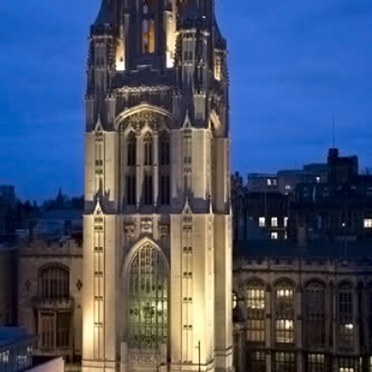Wills Memorial Tower, Bristol
- Lamp efficacy
Lamp efficacy
Ensuring the lamp efficiently converts electricity into light (lm/W).
- Ballast classification
Ballast classification
Controlling the electricity supply to the lamp (Energy Efficiency Index).
- Luminaire distribution
Luminaire distribution
Controlling light emission using optics which bend and shape the light to the correct location.
- System efficacy
System efficacy
Combining optical and thermal control within the luminaire (luminaire lm/W).
- Presence/absence detection
Presence/absence detection
Presence: Lights automatically turn on/off with movement. Absence: Lights automatically turn off and must be manually switched on.
- Daylight detection
Daylight detection
Artificial lighting which responds to the natural light conditions.
- Constant illuminance
Constant illuminance
A function designed to produce correct light levels for the duration of the maintenance period.
- Task-scene setting
Task-scene setting
Allowing the user to set scenes and adapt the lighting to different tasks.
- Timed off
Timed off
Automatic cut-off can be installed to turn all lights off during unoccupied hours.
- Task lighting
Task lighting
Lighting task areas with the correct amount of light.
- Zoning of lighting
Zoning of lighting
Lighting is zoned according to area use.
- Maintenance schedule
Maintenance schedule
Maintenance must be performed in response to product age, performance and environment.
- Waste light
Waste light
Eliminating waste light which does not hit the intended target.
- Reflectance
Reflectance
Taking advantage of light which is reflected from the surface within the space.
- Visible smart metering
Visible smart metering
Results of actions can be quickly seen as increased or decreased energy use to encourage responsible energy consumption.
Thorn lights up Bristol's skyline
Perched high above the city of Bristol, the Wills Memorial Tower - the centrepiece building of the University of Bristol - simply faded into darkness each night. Now, a new floodlighting scheme, made possible thanks to a £750,000 restoration project to return the tower to its original colour, has been supplied. And once again the Tower's high profile has been restored.
Performance
The scheme illuminates the 68-metre-high gothic style tower using primarily low wattage "white" metal halide lamps to enhance the sandy Bath and Clipsham stone.
Efficiency
The University has worked closely with Planning and Conservation Officers from Bristol City Council and with English Heritage to ensure that the scheme is environmentally friendly as well as in keeping with the building and its surroundings. The floodlights are energy-efficient, employ attachments to tailor the beam distributions and are switched on at dusk and off at midnight. Additionally, far less light is needed on a clean stone building than on one which is encrusted with the grime of centuries. The total load is under 6kW.
Comfort
The use of eight 150W Contrast C floodlights cast a glancing light across the face of the tower, the lower part of which is lighted by four 70W ground recessed Mica B floods mounted close to the base. These are augmented by 30 narrow beam 150W Sunspot units to highlight the upper levels at a shallow angle to emphasise detail and shadow. Within the octagonal belfry 70W high pressure sodium Areafloods create a subdued golden glow providing a contrast with the metal halide used elsewhere.
Dave Skelhorne, the University's Contract Supervisor, said: "Switching on the lights was the final piece in the jigsaw of repair, renovation and illumination of the tower - a mammoth project which has taken two years to complete. The tower looks truly magnificent and will now be an even more impressive sight on the city's skyline."
Harry Patch, a 109-year-old veteran of the Great War and a member of the workforce which constructed the tower in the 1920s, switched on the new floodlights.
Electrical work was by AMP Electrical Ltd of Bristol.

